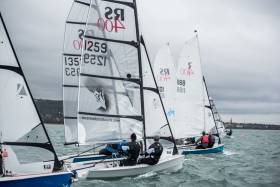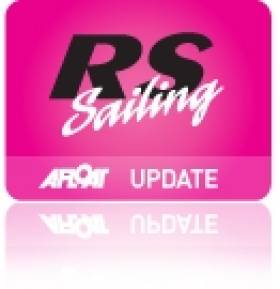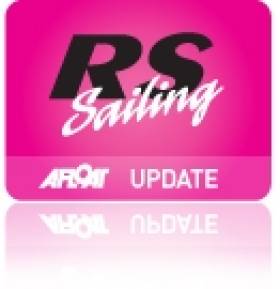Displaying items by tag: RNIYC
Kearney and Nelson Hold a Commanding Lead in RNIYC GP14 Spring Series With One Race Day to Go
Racing resumed in the Royal North of Ireland Yacht Club’s GP14 Spring Series on Sunday 26 March after a brief break for Mother’s Day the previous weekend, writes Joe Devitt.
The forecast was good, the sun shining and apart from the northeasterly breeze which brought a slight chill, there were almost perfect, if somewhat patchy, sailing conditions on Belfast Lough in Northern Ireland.
Gerry Reid and his on-the-water team set the windward/leeward course and a slightly reduced fleet of nine resumed their nautical battling once again.
First to the weather mark in Race 1 were Keith and Matteo Louden from Lough Foyle Yacht Club who sailed a flawless race and maintained their lead for two laps to the finish. Hot on their heels were Ross Kearney and Daniel Nelson (RNIYC/Newtownards SC), Ruan and Natasha O’Tiarnaigh (Ballyholme YC/Sutton Dinghy Club) and Jane Kearney and Rebekah O’Tiarnaigh (RNIYC/BYC).
In the medium conditions the wind was surprisingly patchy and gains and losses were regularly made. The boats finished in the above order, with Steven Nelson and Martin Weatherstone fifth.
The second race saw Ross and Daniel make a lovely start at the pin and sailing into fresher breeze on the left gained an advantage on the fleet which he maintained to the finish.
Steven and Martin battled Jane and Bekka, Ruan and Tasha and the pair of Michael Cox and Claire Crommie (NSC) in close-quarters action, finishing with Steven and Martin second, Ruan and Tasha third and Jane and Bekka fourth, with Michael and Claire having their best result of the day in fifth.
The third race saw Curly Morris and Rachael Stewart (East Anrim BC/NSC) in the mix at the first weather mark along with Ross and Daniel with Keith and Matteo in close proximity. However, it was the second weather mark which proved decisive when Ross and Daniel hit the mark and did a turn causing them to fall back.
Ruan and Tasha took advantage of this and sought more wind on the right-hand side of the run, returning to the leeward gate with a small lead which they held to the finish, followed by Keith and Matteo, Steven and Martin and Ross and Daniel.
The last race of the day saw the first use of the black flag this series as the change in tidal direction caused the enthusiasm of the fleet to result in a general recall. After a tremendous tussle which saw all the protagonists feature at one stage or another, it was a second race win for Ross and Daniel. Second across the line but black-flagged were Ruan and Tasha, giving second to Keith and Matteo, Steven and Martin third, Curly and Rachael fourth and Jane and Bekka fifth.
Also noteworthy are Peter and Andrew Todd, and Rory Higgins and Adam Torrens who raced valiantly and although they didn’t feature in the smaller finishing numbers are training well and gaining the much-needed experience to progress up the fleet.
Looking at the overall scores after four Sundays with one Sunday remaining, Ross Kearney and Daniel Nelson have a commanding lead on 18 points; Ruan and Natasha O’Tiarnaigh are second on 34 points, closely followed by Steven Nelson and Martin Weatherstone on 35 points and Keith and Matteo Louden on 39 points.
The full race results including Day 4 are attached below.
Last Chance to Register for RYANI Cruising Conference 2023
Now is your chance to secure a spot at this year’s RYA Northern Ireland Cruising Conference, which will take place on Saturday 28 January at the Royal North of Ireland Yacht Club in Cultra, Co Down on Belfast Lough.
The conference will be jam-packed with information, expert advice and opportunities to meet others from the cruising community, as well as the RYANI team.
As previously reported on Afloat.ie, speakers for the day include Carol Paddison and Mel Hyde from the RYA, Paul Magee from PGM Training discussing sea survival and Margie Crawford from East Down Yacht Club telling of her experiences cruising Antarctica.
Registration will begin at 9.30am, with the conference running from 10am until 4.30pm.
Tickets for the event, which includes a two course lunch, cost £35 and there is a reduced fee of £30 for RYA Personal Members. Register for the event HERE.
RYA Northern Ireland Gets Ready for Next Month’s Cruising Conference
RYA Northern Ireland is getting ready for its next Cruising Conference, which will be held at Royal North of Ireland Yacht Club in Cultra, Co Down in the New Year.
The conference takes place on Saturday 28 January and will have an interesting line-up of speakers including Paul Magee on sea survival, Margie Crawford on her trip to Antarctic and RYA representatives discussing areas of concern for boaters in Northern Ireland.
Tickets prices are £30-£35 and include a two-course lunch. For more information and to book a ticket, see the Eventbrite page HERE.
Royal North of Ireland Yacht Club Community Christmas Appeal
With club sailing and fund-raising events sadly curtailed due to Covid 19, the members of Royal North of Ireland Yacht Club on Belfast Lough have devised a safe way of helping the many families and individuals in the community who are struggling to survive and are facing a bleak Christmas. Commodore Irene Aston is asking for donations to support the work of the North Down Storehouse and the Salvation Army's Christmas Present Appeal.
Every year Members and their guests generously support charities nominated by the Commodore and others. During 2019 the sum raised was over £11,500 for charities including the Mary Peter's Trust, Macmillan Cancer Support, Parkinsons UK Northern Ireland, and in support of the RNLI Holywood Branch.
"Every year Members and their guests generously support charities nominated by the Commodore and others"
Examples of useful items can be obtained from the club office by email to [email protected] or by phone on 028 9142 8041, and you can still access the Club during office hours until the end of November to leave donations in the Commodore's Room.
Commodore Irene Aston is appealing for support from the members: " Sadly, this year we have been unable to run any of our usual fundraising events including our Regatta, but this doesn't mean that we can't do something to help our local community in these very hard times. When you're next at the supermarket or just shopping for Christmas, please put something extra in your bag to help someone less fortunate and drop it off at the Club next time your passing. I look forward to proudly delivering our donations to Storehouse and the Salvation Army in good time for Christmas. My sincere thanks to you all for your support and please remember to stay safe".
Bosun Bob’s RS 400 Autumn Series Concludes At Royal North
#RS - Sunday 17 December saw the end of the Bosun Bob’s RS 400 Autumn Series hosted annually at Royal North of Ireland Yacht Club.
The series has built up over the last 10 years to now have up to 18 boats on the start line in Cultra every Sunday for the eight weeks, with the hardy sailors and race committee braving some tricky and sometimes bitterly cold conditions on Belfast Lough.
The race team try to get four short bullet back-to-back races of around 15-20 minutes each. This strategy has proven to be very popular with the competitors, encouraging new members to join the class of the performance two-man boats.
Competition at the top was very tight in this year’s series, but after 16 races the Bosun Bob’s trophy went to Paul McLaughlin and Owen McKinley.
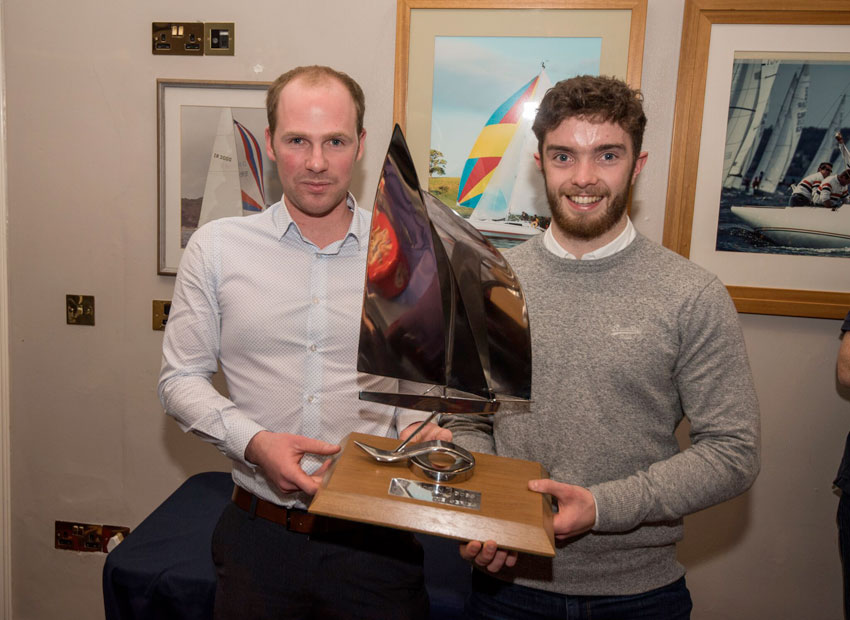
The final races also welcomed a seasonal guest competitor in the shape of Santa Claus himself!
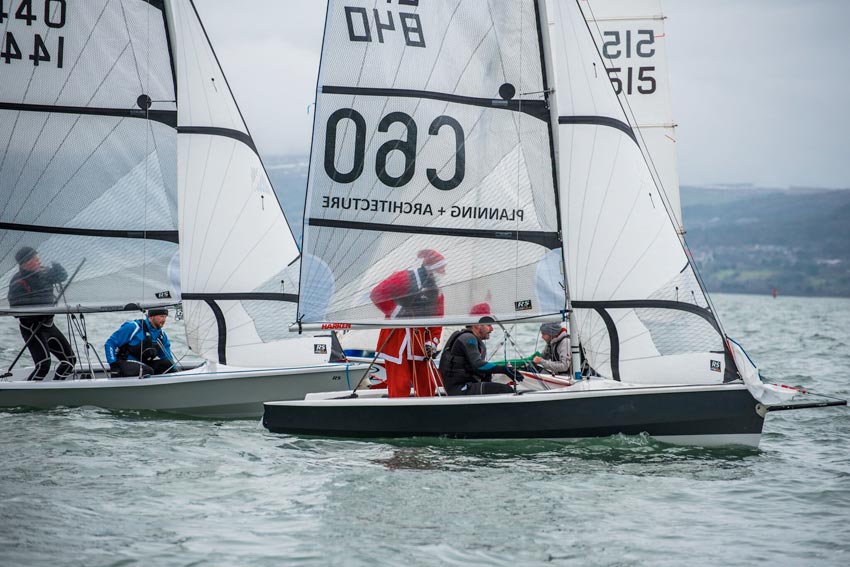
RS 400 racing at the Royal North is due to resume with the Spring Series in mid February 2018.
Photos: Bradley Quinn
RS Sailors Take to Belfast Lough for Royal North's Autumn Series
#rssailing – RS Sailor David Cheyne reports from Day four of Royal North Ireland's (RNIYC) Autumn Series on Belfast Lough.
You know the way you can want something so badly that you can convince yourself it is something entirely different, well that is what happens when you haven't sailed for 4 weeks due to a truculent weather God, and the relaxed kite pop in 15 knots turns out to be an underestimate by about 100% as you nearly shoot out the back of the boat..... Well, after a drifter on the first Sunday and a couple of hurricanes' backsides on Days 2 and 3, racing of a sort got underway at last at RNIYC today, in a rather fruity 15-29 knots of sunshiney gloriousness.
Why would you sail a simple single hander when you can sail something much more complicated and thus amplify the opportunity for snarl ups, as ably demonstrated by Chrs Penney, who arrived late, with no sheets. Once the appropriate strings had been commandeered from a variety of sources, the Irish Champion, taking time out from his intensive youth squad coaching duties (i.e. Boat preparation, racing tactics etc) promptly yotted off to the race area under limited control, due to his tiller extension not being attached to his tiller, really....
Lots of bits fell off today, including Laura O'Hallorahoolahan, from 1230, and the evergreen Ginge from 825, launching himself unnaturally skyward, into a high tariff dive which drew no applause from Trevor D'Arcy, who was probably wondering if getting back into the class again was going to be as simple as it might have been. For some reason the old timers also decided to drop their kite by pulling the pole out of the front of the boat and cutting the launch line.... always carry a sharp knife when big boat sailing – old habits die hard. Slot gaskets were inspected by all, and by some, such as Dr Hutch and Stuart A, repeatedly, despite Dr H's assertion that No More Nails was just as good as the correct glue. Well I can tell you that it doesn't work as well, and my temporary fix using NMN at Mounts Bay finally succumbed to the endless high wind battering we have had since then, to deliver another fine torrent of foamy sea through the middle of my cockpit. Boat preparation is key it seems.
So onto racing, because that was why we were there, albeit those ashore having lunch might have queried what exactly we were all up to. 12-14 ships set out, and in charge if cat herding was as ever, our long suffering Race Kommandant, Gerry Reid. After giving up waiting for all the boats to be the right way up at the same time, hostilities were commenced, with only one boat capsized on the start line as the sequence started (probably a tactic). Entering the fray, rather later than planned, were Charlie and Wendy, hosing in at mach 2, with their pink kite slightly dictating play, demonstrating that it was still pretty windy. Not sure what happened then, as they came third, so presumably got her spun round in double quick time. Boshing upwind in 20+ knots, DrC and Stevie K punched out a few lengths, and approaching the first mark went for a conservative rounding, which was of course, a red rag to our very own Dick Turpin, Uncle Liam, who saw the gap and snuck through to take the lead. Some fishing by DrC allowed Liam to extend quickly, before a game of hunt the leeward mark broke out. The cleverly camouflaged buoy, sea green in colour, was eventually spotted deeper than expected, taking all the excitement out of the run. Well, there was of course the option of sending it and popping a couple of gybes, but that seemed unwise, and everyone bumbled boringly to the bottom of the course. Lap 2 got a bit livelier again, and it all kicked off at the second top turn, as the gauge strained and, as DC went all softy and declined to pull the trigger on the hoist, the lemmings behind all sniffed a chance, as chutes were launched. This prompted Uncle Liam and Johnny O to stack it and send it over the handlebars, followed by everyone else, who seemed to think this was part of the game. A healthy lead thus established, DrC further embarrassed his family by tacking around at the gybe, providing a good view of the swimming competition behind.
As it looked worse than it was, the rescue cavalry arrived, including the Start/Finish RIB, only to discover that everyone was in fact enjoying the communal activity, leaving Dr C to round the last mark, with no line to finish at. True to form, our erstwhile mobile Race Officer reappeared like Mr Ben, as the leaders arrived at the finish, and rewards were handed out to Dr C/ Steve, and then the two lady crew, with Laura and Paul in second, and Charlie and Wendy in third. The rest all bumbled in thereafter, and with Gerry declaring the whole thing unwise, we all headed for shore. Well, we were meant to, only it was too much fun, so kites were hoisted here there and everywhere, as we all, rather unhelpfully, to the safety teams, went for a quick last blast before bedtime. No harm done, and apologies duly offered and accepted by the Race Team, I think.
Day 6, races 2-4, Report
15 races scheduled so far, one completed, things could only get better, and so it came to pass, the sun came out, the wind appeared from a glassy lough, and we were offski. Crew swapping done, leaving Liam to speak to his attorney, we headed off for a jolly good bunfight in the shiftless NE 5-7 knots, albeit too light for any injuries or embarrassing scenarios to arise.
DrC nipped out in Race 1 of the day, and a procession ensued, Darcy in first loser spot, followed by event sponsor Bosun Bob, of the little shop on the corner opposite the Marina, doing a great pre-Christmas deal on ships in a bottle. Not a very exciting race really, but it served to double the achievement to date.
Race two was a bit more of a shuffle, with traffic jams at the bottom mark leading to inversions of order, and some shoddy roundings by most. Darcy snuck through by taking the great circle route round the fence stallers, jumping up 4 spots to take the lead coming to the top for the second time. DrC made some ground and tried to snare the men from Carrick, but missed the catch, momentarily, before managing to poke them up the bum with his pole, and conceded to a quick spin to relieve the impropriety. Bit more shuffling and Paul McLaughlin nipped through to take the first of his two first-loser slots of the day. Darcy rumbled on to take the biggest rosette.
Race three was abandoned half way up the beat, after a 30 degree leftie as the start gun fired confused everyone, and left Cushendall man McLaughlin leading the lopsided fleet in a straight line to the first mark. Some felt this to be the right decision by Gerry Reid, our erstwhile Race Officer, though Paul knew fine rightly it was because he was from Cushendall.
Determined to flick his thumb off the underside of his top teeth at the process, Paul promptly raced into a lead in the final race of the day, and looked to have it in the bag, when a masked man on a galloping horse made an unexpected appearance, riding in to pinch it off him.
The day's top performer was probably Bosun Bob, with some great speed and a very consistent 3,4,4, showing his blue boat has clearly exorcised the demons of his red hull of yore.
Steady Force 4 and blue skies on the cards next Sunday, so bring it on again in a week.
Results sheet downloadable below.
RS400s Take to Belfast Lough for Royal North Series
#rssailing – 13 RS 400s came to the Royal North of Ireland line yesterday, with boats coming from Cushendall, Dublin and Ballyholme. The RNIYC series runs for another six weeks, breaking for Christmas, then starting again for 12 weeks as the 'Frosties'.
RS Elite Ireland
Graham Smith wrote, in the March 2009 issue of Afloat: "The RS stable was further enhanced by the arrival of the RS Elite keelboat class on Belfast Lough in 2006 and in less than two years, it has grown to 13 boats with five more expected in the Lough for 2009. Interest has been expressed in Cork, Dublin and Galway so 2009 may prove to be a turning point for the Elite.
The fact that the European Championships are being hosted by Royal North of Ireland YC at Cultra next June is the carrot to encourage expansion and the class promoters will no doubt be highly active over the winter months to attract more sailors to its fleet.
Simon Brien of Dragon, Squib, etc., fame has already been bitten by the bug and duly won the first ever Elite Nationals in the appropriately named ‘Athelites’. Clubmate Jeff Ralston won the inaugural Northerns in a nine-strong fleet. National Champion: Simon Brien, RNIYC."
RS Elite Ireland, c/o Gerry Reid, President, Royal North of Ireland Yacht Club, 7 Seafront Road, Cultra, Holywood BT18 0BB, N. Ireland. Tel:0044 777 484 9998, email: [email protected]



























